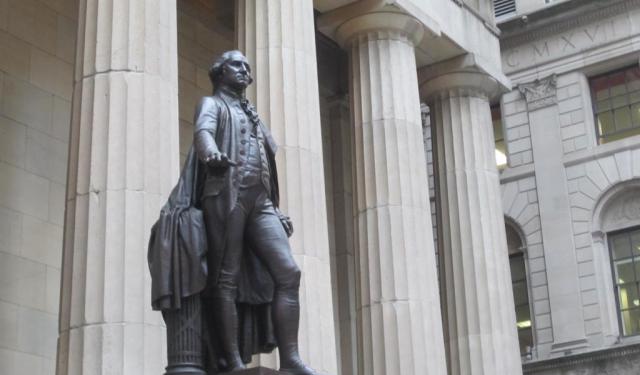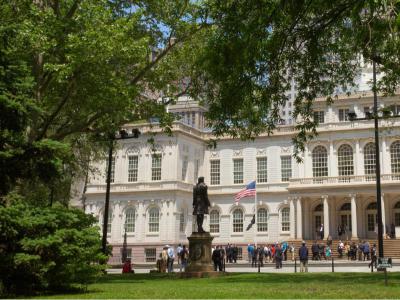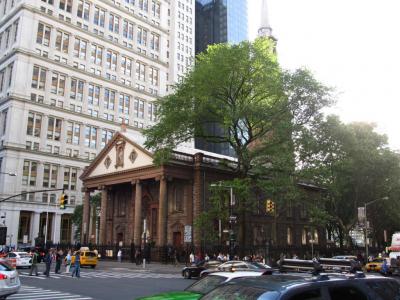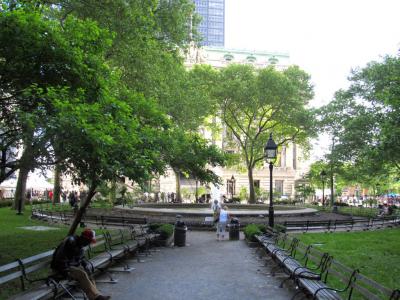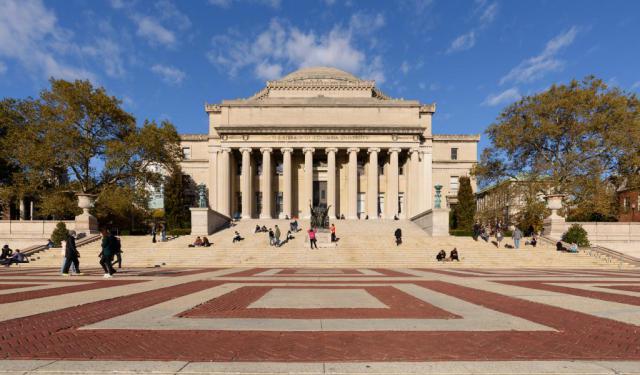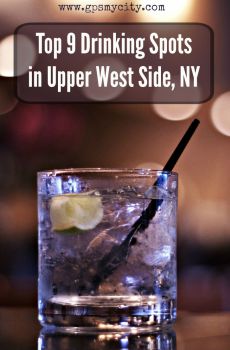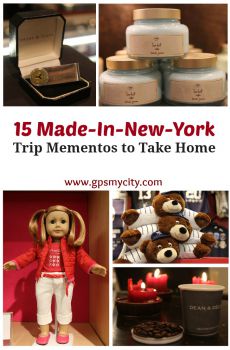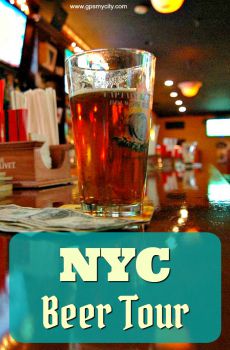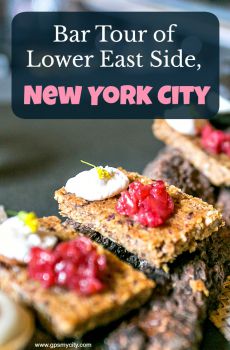George Washington's New York (Self Guided), New York
While not really a New York fan himself, George Washington held the city in high esteem, calling it “a post of infinite importance,” and is even credited with coining the term “New Yorker”. The scene of some of Washington’s greatest military trials and political triumphs, NYC is a home to several important sites associated with his life and career, such as Fraunces Tavern, Bowling Green, St. Paul’s Chapel, and more.
Begin your tour with a stroll through the cool little City Hall Park in the heart of the very old part of Manhattan, where on July 9, 1776, people gathered in the commons to hear the Declaration of Independence read by George Washington. Thirteen years later, in the nearby Federal Hall, General Washington was named the first president of the United States and immediately after his inauguration, he went to the renowned St. Paul’s Chapel – Manhattan’s oldest surviving church - for a prayer.
After a fire in 1776 and major collapse in 1838, the 3rd Trinity Church is another fascinating sight whose parishioners included Alexander Hamilton (the face of the $10 bill), John Jay and George Washington. If not to say a prayer, the building’s history and architecture are enough to merit a visit and pay respects.
Round out with a visit to the Fraunces Tavern and the Bowling Green – an integral part of the president’s new landscape plan which he designed and implemented between 1784-87, including a lawn for playing the game of lawn bowls. Encircled with high-rise buildings, it’s just the right place for a break before pursuing further in your NYC adventures.
If you want to explore Washington's New York City in a beautiful historic area complete with pre-Revolutionary War landmarks and monuments, join us on this self-guided walking tour.
Begin your tour with a stroll through the cool little City Hall Park in the heart of the very old part of Manhattan, where on July 9, 1776, people gathered in the commons to hear the Declaration of Independence read by George Washington. Thirteen years later, in the nearby Federal Hall, General Washington was named the first president of the United States and immediately after his inauguration, he went to the renowned St. Paul’s Chapel – Manhattan’s oldest surviving church - for a prayer.
After a fire in 1776 and major collapse in 1838, the 3rd Trinity Church is another fascinating sight whose parishioners included Alexander Hamilton (the face of the $10 bill), John Jay and George Washington. If not to say a prayer, the building’s history and architecture are enough to merit a visit and pay respects.
Round out with a visit to the Fraunces Tavern and the Bowling Green – an integral part of the president’s new landscape plan which he designed and implemented between 1784-87, including a lawn for playing the game of lawn bowls. Encircled with high-rise buildings, it’s just the right place for a break before pursuing further in your NYC adventures.
If you want to explore Washington's New York City in a beautiful historic area complete with pre-Revolutionary War landmarks and monuments, join us on this self-guided walking tour.
How it works: Download the app "GPSmyCity: Walks in 1K+ Cities" from Apple App Store or Google Play Store to your mobile phone or tablet. The app turns your mobile device into a personal tour guide and its built-in GPS navigation functions guide you from one tour stop to next. The app works offline, so no data plan is needed when traveling abroad.
George Washington's New York Map
Guide Name: George Washington's New York
Guide Location: USA » New York (See other walking tours in New York)
Guide Type: Self-guided Walking Tour (Sightseeing)
# of Attractions: 6
Tour Duration: 1 Hour(s)
Travel Distance: 1.6 Km or 1 Miles
Author: DanaOffice
Sight(s) Featured in This Guide:
Guide Location: USA » New York (See other walking tours in New York)
Guide Type: Self-guided Walking Tour (Sightseeing)
# of Attractions: 6
Tour Duration: 1 Hour(s)
Travel Distance: 1.6 Km or 1 Miles
Author: DanaOffice
Sight(s) Featured in This Guide:
- City Hall Park
- St. Paul's Chapel
- Federal Hall
- Trinity Church
- Bowling Green Park
- Fraunces Tavern
1) City Hall Park
While Boston and Philadelphia are thoroughly steeped in revolutionary history, New York’s contribution to the American independence is little noted despite the greatest price it had paid in terms of death and human suffering. Part of New York’s revolutionary heritage is closely associated with City Hall Park, a public park surrounding New York City Hall in the Civic Center of Lower Manhattan. During the Revolutionary era this part of the city was the site of many rallies and movements.
The Declaration of Independence may well have been enacted in Philadelphia, but the first soldiers rising bravely to the defense of American liberty were in New York. On July 9, 1776, the word of the newly signed Declaration reached George Washington, upon which he gathered his men on the New York Common, now City Hall Park, and had the Declaration read out to them, exhorting the troops to be worthy of the newly independent nation whose uniform they wore.
The very first blood of struggle for the cause was shed on the New York Common. On August 11, 1766, the Sons of Liberty, a secret revolutionary organization advancing the rights of European colonists in American Colonies, erected the first Liberty Pole featuring the word “Liberty” outside the barracks of the British occupation force. Although the British soldiers had it chopped down, the post was repeatedly replaced – five times in total. A replica dating to 1921 now stands near its original location between City Hall and Broadway. On November 9, 1783, after the American troops recaptured the Civic Center, George Washington raised the American flag in the park for the first time.
Also, the park houses a monument honoring America's most famous Revolutionary-era martyr, Nathan Hale, a 21-year-old American spy. A graceful, 13-foot bronze statue set upon a granite base, facing the City Hall directly, illustrates the last moments of the hero shackled and bound. The statue is inscribed with the last words he had uttered prior to being hung by the British, "I only regret that I have but one life to lose for my country."
The Declaration of Independence may well have been enacted in Philadelphia, but the first soldiers rising bravely to the defense of American liberty were in New York. On July 9, 1776, the word of the newly signed Declaration reached George Washington, upon which he gathered his men on the New York Common, now City Hall Park, and had the Declaration read out to them, exhorting the troops to be worthy of the newly independent nation whose uniform they wore.
The very first blood of struggle for the cause was shed on the New York Common. On August 11, 1766, the Sons of Liberty, a secret revolutionary organization advancing the rights of European colonists in American Colonies, erected the first Liberty Pole featuring the word “Liberty” outside the barracks of the British occupation force. Although the British soldiers had it chopped down, the post was repeatedly replaced – five times in total. A replica dating to 1921 now stands near its original location between City Hall and Broadway. On November 9, 1783, after the American troops recaptured the Civic Center, George Washington raised the American flag in the park for the first time.
Also, the park houses a monument honoring America's most famous Revolutionary-era martyr, Nathan Hale, a 21-year-old American spy. A graceful, 13-foot bronze statue set upon a granite base, facing the City Hall directly, illustrates the last moments of the hero shackled and bound. The statue is inscribed with the last words he had uttered prior to being hung by the British, "I only regret that I have but one life to lose for my country."
2) St. Paul's Chapel
Saint Paul's Chapel is an Episcopal church on the Columbia University campus. It was a gift to the campus from sisters Caroline Phelps Stokes and Olivia Egleston Phelps Stokes.
Construction of the church began in 1903 and was completed in 1907. It was designed by I.N. Phelps Stokes, nephew of the sisters who gifted the building to the campus. The church is influenced by a myriad of architectural styles, including Northern Italian Renaissance Revival, Byzantine and Gothic.
Saint Paul's Chapel has a number of unique features in its interior. The 91-foot tall dome has 16 stained-glass windows that display coats of arms belonging to distinguished graduates.
Memorial tablets are also installed throughout the chapel. They are placed in honor of teachers and administrators, including Seth Low, the former college president, who was instrumental in moving Columbia University to Morningside Heights.
Saint Paul's Chapel has often been recognized in popular culture. The Simon & Garfunkel classic "The Boxer" was partially recorded here. It was also featured in the Barbra Streisand film "The Mirror Has Two Faces."
Construction of the church began in 1903 and was completed in 1907. It was designed by I.N. Phelps Stokes, nephew of the sisters who gifted the building to the campus. The church is influenced by a myriad of architectural styles, including Northern Italian Renaissance Revival, Byzantine and Gothic.
Saint Paul's Chapel has a number of unique features in its interior. The 91-foot tall dome has 16 stained-glass windows that display coats of arms belonging to distinguished graduates.
Memorial tablets are also installed throughout the chapel. They are placed in honor of teachers and administrators, including Seth Low, the former college president, who was instrumental in moving Columbia University to Morningside Heights.
Saint Paul's Chapel has often been recognized in popular culture. The Simon & Garfunkel classic "The Boxer" was partially recorded here. It was also featured in the Barbra Streisand film "The Mirror Has Two Faces."
3) Federal Hall
The original Federal Hall at 28 Wall Street in Lower Manhattan was built in 1703. It replaced the old Stadt Huys, the first city hall in New York City, built in the 17th century during Dutch colonial times. The new structure was used as a city hall, a library, a firehouse, and a debtors prison. The Stamp Act Congress and the Continental Congress met there. The inauguration of George Washington as the first President of the United States was held on April 30, 1789, on the balcony of Federal Hall.
The Federal Hall, demolished in 1812, was replaced by the Greek Revival-style Federal Hall. The new building, designed by architects Ithiel Town and Alexander J. Davis, was completed in 1842. The neoclassical edifice served as the U.S. Customs House and eventually the U.S. Sub-Treasury. It is today the Federal Hall National Memorial.
The building has a rotunda dome by sculptor John Frazee. The Greek Revival structure is built with Tuckahoe marble. The 18 steps of the main entrance are five-foot granite blocks. A large bronze sculpture of George Washington by sculptor John Quincy Adams Ward is installed on the front steps. The statue was unveiled in 1883 to commemorate the first inauguration of George Washington.
Doric colonnades hold up a triangular pediment. There are flat pilasters on the Nassau Street facade. The rotunda is 60 feet in diameter. It is an amphiprostyle with balconies. The wall of the rotunda has four sections, each containing four columns. A saucer dome tops the rotunda, covered with a circular skylight. The floor has marble blocks in a circular pattern. A stone in the center marks the spot where Washington once stood.
Federal Hall operates as a national memorial. It has tourist information about the monuments and parks in the New York Harbor area and a New York City tourism information center. The memorial has several exhibits open to the public. The gift shop has colonial and early American items for sale.
The Federal Hall, demolished in 1812, was replaced by the Greek Revival-style Federal Hall. The new building, designed by architects Ithiel Town and Alexander J. Davis, was completed in 1842. The neoclassical edifice served as the U.S. Customs House and eventually the U.S. Sub-Treasury. It is today the Federal Hall National Memorial.
The building has a rotunda dome by sculptor John Frazee. The Greek Revival structure is built with Tuckahoe marble. The 18 steps of the main entrance are five-foot granite blocks. A large bronze sculpture of George Washington by sculptor John Quincy Adams Ward is installed on the front steps. The statue was unveiled in 1883 to commemorate the first inauguration of George Washington.
Doric colonnades hold up a triangular pediment. There are flat pilasters on the Nassau Street facade. The rotunda is 60 feet in diameter. It is an amphiprostyle with balconies. The wall of the rotunda has four sections, each containing four columns. A saucer dome tops the rotunda, covered with a circular skylight. The floor has marble blocks in a circular pattern. A stone in the center marks the spot where Washington once stood.
Federal Hall operates as a national memorial. It has tourist information about the monuments and parks in the New York Harbor area and a New York City tourism information center. The memorial has several exhibits open to the public. The gift shop has colonial and early American items for sale.
4) Trinity Church
Trinity Church is a traditional high church located not far from the intersection of Wall Street and Broadway in Lower Manhattan. Renowned for its storied past and endowment, this historic temple has been around since the late 17th century.
Originally built in 1698, the church had been remodeled three times until the current edifice came in 1846. Over the centuries, the Manhattan Trinity Church has held an important place in American history. During the American Revolution, it served as the British headquarters before being destroyed by the Great Fire of New York in 1776. The replacement building was completed in 1790 and saw many of the Nation's Founding Fathers, including Alexander Hamilton and John Jay, attending services. President Washington and members of his government often worshiped there.
The burial grounds outside the church are a who's who of the early days of the Nation. Alexander Hamilton is buried here alongside his wife and son. Hamilton was the Nation's first Secretary of the Treasury after George Washington was elected president in 1789. Following Washington's death in December 1799, for a brief period, he was also the most senior-ranking officer in the U.S. Army until his retirement a year later.
Among other notable figures buried at Trinity are William Bradford (English printer, often referred to as "the pioneer printer of the Middle colonies"), Robert Fulton (American engineer and inventor of commercial steamboat), William Alexander (also known as Lord Stirling, a Scottish-American major general during the American Revolutionary War), Francis Lewis (a signer of the United States Declaration of Independence as a representative of New York), Hercules Mulligan (Irish-American tailor and spy during the American Revolutionary War), Edward Irving Koch (the mayor of New York City from 1978 to 1989), and others. Remarkably, the Trinity Church graveyard is also the only cemetery in Manhattan still in service.
Originally built in 1698, the church had been remodeled three times until the current edifice came in 1846. Over the centuries, the Manhattan Trinity Church has held an important place in American history. During the American Revolution, it served as the British headquarters before being destroyed by the Great Fire of New York in 1776. The replacement building was completed in 1790 and saw many of the Nation's Founding Fathers, including Alexander Hamilton and John Jay, attending services. President Washington and members of his government often worshiped there.
The burial grounds outside the church are a who's who of the early days of the Nation. Alexander Hamilton is buried here alongside his wife and son. Hamilton was the Nation's first Secretary of the Treasury after George Washington was elected president in 1789. Following Washington's death in December 1799, for a brief period, he was also the most senior-ranking officer in the U.S. Army until his retirement a year later.
Among other notable figures buried at Trinity are William Bradford (English printer, often referred to as "the pioneer printer of the Middle colonies"), Robert Fulton (American engineer and inventor of commercial steamboat), William Alexander (also known as Lord Stirling, a Scottish-American major general during the American Revolutionary War), Francis Lewis (a signer of the United States Declaration of Independence as a representative of New York), Hercules Mulligan (Irish-American tailor and spy during the American Revolutionary War), Edward Irving Koch (the mayor of New York City from 1978 to 1989), and others. Remarkably, the Trinity Church graveyard is also the only cemetery in Manhattan still in service.
5) Bowling Green Park
Bowling Green is a small public park in the Financial District of Lower Manhattan. It was an area of public use since Dutch colonial days when it was also home of Fort New Amsterdam. The place was officially designated as a park in 1733.
Enclosed in its 18th-century iron fence, Bowling Green is the oldest park in New York City. The park actually was a bowling green early on and it had a statue of King George III on horseback. George came down with the American Revolution.
Bowling Green was a notable historical site. There was a settlement of the indigenous Lenape people at the end of the Wickquasgeck Trail, which later became Broadway. It was at the site of Bowling Green where the Dutch colonial governor of New Amsterdam, Peter Minuit, bought Manhattan Island from the Lenape in 1626. Minuit paid a grand total of $24 worth of trinkets for the purchase.
In the early years, elegant federal-style townhouses were built around the park. President George Washington resided at the Alexander Macomb House, on the north of the park at 39-41 Broadway. Washington lived in the house from February 23 to August 30, 1790, when the U.S. capital was moved to Philadelphia.
The park is an elliptical plaza. There is a large fountain in the center of the fenced-in lawn. A bronze sculpture of a "Charging Bull," designed by artist Arturo Di Modica, weighs 7,000 pounds. "Fearless Girl," by sculptor Kristen Visbal, faced off against the bull until she was moved in 2017 to face off against the New York Stock Exchange.
Enclosed in its 18th-century iron fence, Bowling Green is the oldest park in New York City. The park actually was a bowling green early on and it had a statue of King George III on horseback. George came down with the American Revolution.
Bowling Green was a notable historical site. There was a settlement of the indigenous Lenape people at the end of the Wickquasgeck Trail, which later became Broadway. It was at the site of Bowling Green where the Dutch colonial governor of New Amsterdam, Peter Minuit, bought Manhattan Island from the Lenape in 1626. Minuit paid a grand total of $24 worth of trinkets for the purchase.
In the early years, elegant federal-style townhouses were built around the park. President George Washington resided at the Alexander Macomb House, on the north of the park at 39-41 Broadway. Washington lived in the house from February 23 to August 30, 1790, when the U.S. capital was moved to Philadelphia.
The park is an elliptical plaza. There is a large fountain in the center of the fenced-in lawn. A bronze sculpture of a "Charging Bull," designed by artist Arturo Di Modica, weighs 7,000 pounds. "Fearless Girl," by sculptor Kristen Visbal, faced off against the bull until she was moved in 2017 to face off against the New York Stock Exchange.
6) Fraunces Tavern
Fraunces Tavern is a landmark museum and a restaurant in the Financial District of Lower Manhattan, sitting on the corner of Broad Street and Pearl Street. Opened in 1762 by restauranteur Samuel Fraunces, this location features much of the revolutionary history of New York before, during, and after the American Revolution. It was once the headquarters for George Washington, a venue for peace negotiations with the British, and a federal office in the Early Republic.
On the inside, Fraunces happens to be bigger than it looks on the outside. Whilst here, you may wish to see the lobby frequented by the likes of George Washington during the American Revolution or the Long Room, where Washington and his officers gathered for a “turtle feast” dinner on December 4, 1783, to celebrate British withdrawal from New York.
George Washington himself was a big fan of Fraunces’ cooking and even made the innkeeper his presidential steward. He generally liked taverns and booze and even named his three dogs Tipsy, Tippler, and Drunkard. As part of the American Whiskey Trail and the New York Freedom Trail, Fraunces is a must-go tourist site for history, whiskey, and beer lovers.
The whiskey bar has the best selection in the city, and the tavern’s beer selection is well-stocked. The restaurant serves a traditional American menu, offering meatloaf, steak, various sandwiches, and salads, plus desserts. The steak, Fillet Mignon on a Stone, is highly recommended!
The museum tells the story of the building, along with varied exhibitions of art and artifacts.
On the inside, Fraunces happens to be bigger than it looks on the outside. Whilst here, you may wish to see the lobby frequented by the likes of George Washington during the American Revolution or the Long Room, where Washington and his officers gathered for a “turtle feast” dinner on December 4, 1783, to celebrate British withdrawal from New York.
George Washington himself was a big fan of Fraunces’ cooking and even made the innkeeper his presidential steward. He generally liked taverns and booze and even named his three dogs Tipsy, Tippler, and Drunkard. As part of the American Whiskey Trail and the New York Freedom Trail, Fraunces is a must-go tourist site for history, whiskey, and beer lovers.
The whiskey bar has the best selection in the city, and the tavern’s beer selection is well-stocked. The restaurant serves a traditional American menu, offering meatloaf, steak, various sandwiches, and salads, plus desserts. The steak, Fillet Mignon on a Stone, is highly recommended!
The museum tells the story of the building, along with varied exhibitions of art and artifacts.
Walking Tours in New York, New York
Create Your Own Walk in New York
Creating your own self-guided walk in New York is easy and fun. Choose the city attractions that you want to see and a walk route map will be created just for you. You can even set your hotel as the start point of the walk.
Midtown Manhattan Walking Tour
If you’ve ever pictured New York City as a canyon of skyscrapers, glowing billboards, and streets that pulse with constant activity, Midtown Manhattan is the version you likely imagined. Hard to believe, but this buzzing district started out as open farmland—proof that even the busiest corners of the world have humble beginnings... Everything changed after the Commissioners’ Plan of 1811... view more
Tour Duration: 2 Hour(s)
Travel Distance: 4.1 Km or 2.5 Miles
Tour Duration: 2 Hour(s)
Travel Distance: 4.1 Km or 2.5 Miles
Times Square to Central Park
A leisurely self-guided stroll from Times Square to Central Park will take you to some of NYC’s prominent locations, each worth visiting in their own right.
At 49th Street, Fifth Avenue lives up to its lofty reputation with the Rockefeller Center, one of the world’s biggest business and entertainment complexes, and a triumph of Art Deco architecture. Like the neighboring Times Square, the... view more
Tour Duration: 2 Hour(s)
Travel Distance: 3.2 Km or 2 Miles
At 49th Street, Fifth Avenue lives up to its lofty reputation with the Rockefeller Center, one of the world’s biggest business and entertainment complexes, and a triumph of Art Deco architecture. Like the neighboring Times Square, the... view more
Tour Duration: 2 Hour(s)
Travel Distance: 3.2 Km or 2 Miles
Columbia University Walking Tour
Established in 1754, Columbia University is the oldest institution of higher education in the state of New York and the fifth-oldest in the United States. A member of the prestigious Ivy League, this renowned institution boasts a diverse campus designed along Beaux-Arts planning principles. Columbia's main campus occupies more than six city blocks in Morningside Heights, New York City, and is... view more
Tour Duration: 2 Hour(s)
Travel Distance: 2.3 Km or 1.4 Miles
Tour Duration: 2 Hour(s)
Travel Distance: 2.3 Km or 1.4 Miles
Brooklyn New York Walking Tour
The story of Brooklyn predates the brownstones and bagels. The area's earliest known inhabitants were the Lenape, the Indigenous tribe also known as the Delaware, who lived along the shores of the East River and Gowanus Bay long before Europeans discovered the uses of potatoes...
The Dutch, who arrived during the 17th century, established several farming villages here, naming one of them... view more
Tour Duration: 2 Hour(s)
Travel Distance: 3.9 Km or 2.4 Miles
The Dutch, who arrived during the 17th century, established several farming villages here, naming one of them... view more
Tour Duration: 2 Hour(s)
Travel Distance: 3.9 Km or 2.4 Miles
NYC's Chinatown and Little Italy Walking Tour
If New York were a giant cookbook, Chinatown and Little Italy would definitely be the chapters where flavors go wild. These two neighbors on Manhattan’s Lower East Side started as modest immigrant enclaves and somehow ended up becoming two of the city’s most recognizable cultural districts. Their stories mirror the bigger tale of New York itself: arrivals from faraway places, tight-knit... view more
Tour Duration: 1 Hour(s)
Travel Distance: 1.6 Km or 1 Miles
Tour Duration: 1 Hour(s)
Travel Distance: 1.6 Km or 1 Miles
Best of Lower Manhattan Walking Tour
Every part of Manhattan is terrific, but if you are looking for one that showcases the best overview of New York City’s history and architectural styles, it’s Lower Manhattan. This is where it all started, where New Amsterdam was founded, where Canal Street used to be a canal, and where Wall Street used to be a wall marking the end of town. It’s also where the city has seen the most tragedy,... view more
Tour Duration: 2 Hour(s)
Travel Distance: 3.1 Km or 1.9 Miles
Tour Duration: 2 Hour(s)
Travel Distance: 3.1 Km or 1.9 Miles
Useful Travel Guides for Planning Your Trip
7 Best Drinking Places in Upper West Side, NY
With “Bar Tour of the Upper West Side” sample a cross section from NYC’s great gamut of drinking establishments, including a Belgian Brasserie, a wine bar, Irish pubs, and one dive — just for fun! These spots offer something a little extra, like craft beers, inspirational artwork, a chance...
NY Villages Best Tea and Coffee
This is a guide to the best tea and coffee shops and houses in the East, West, Washington Square and Greenwich Villages of Manhattan. None of these are chains, so tourists looking to avoid Starbucks can find sanctuary in this app. All of these run the gamut between W and E 14th Streets, and down 1st...
NYC Souvenir Guide: 15 Authentic New York City Products to Take Home
In keeping with the song, one might think that, if they can make it in New York City, they can make it anywhere. Well, not always... Some of the things made in New York City aren't made anywhere else, and you'll definitely want to try or keep at least some of them to prolong your NYC...
NYC Beer Tour
There are many great places to drink in New York City. Still, discerning connoisseurs are likely to find themselves awash in a sea of mediocre beer without first gaining a proper lay of the beer land. For those whose curiosity and taste buds urge them to venture beyond ubiquitious draft staples like...
Bar Tour of Lower East Side, New York City
The Lower East Side has been described the most livable neighborhood in NYC. Unique and dynamic, LES has boutique shops, cafes and restaurants alongside great bars and museums.In this historic neighborhood, residents strive to preserve its roots. Here, you can find young professionals who challenge...
The Most Popular Cities
/ view all
